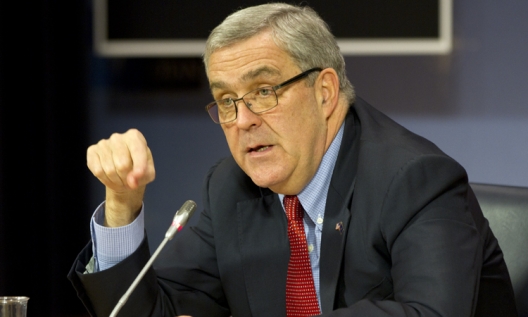 [T]he two organizations have agreed on 40 discreet and I think rather concrete actions that can move us forward towards better cooperation.
[T]he two organizations have agreed on 40 discreet and I think rather concrete actions that can move us forward towards better cooperation.
First of all in the area of a shared responsibility for national resilience. So a national member state ability to resist hybrid attack. We will agree that we will both cooperate in what’s called the European Center for Countering Hybrid Threats. This will be hosted in Finland, and both NATO and the EU will participate.
We agreed that the Fusion Cell in the EU and its counterpart here in NATO that focuses on hybrid challenges will come closer together and begin to synchronize their activities.
We’ve agreed that the two crises response processes, one in the EU and one in NATO, can be synchronized and made parallel so that we respond to crises in a more concerted way.
And we’ve agreed that the two sets of experts — one set in the EU and one set here in NATO — who are on call to respond to requests for assistance from member states will coordinate their activities.
So essentially across this set of challenges having to do with hybrid warfare, hybrid threats, there’s a lot of room for NATO-EU cooperation and we’re going to move forward on that with some of these discreet and very concrete deliverables.
We’ve also agreed in another category to begin to work more closely together with regard to cyber defense, and here there are things we can do by way of training, by way of exercises and by way of standards for cyber defense, national standards for hybrid defense, that just make sense that the EU and NATO talk to one another and begin to cooperate.
Maritime security is the third potential area for cooperation. You’ll appreciate that we’re doing this in a rather modest way in the Eastern Aegean Sea today, but there’s more work to be done and we think in the future NATO will provide logistics support and share information with the ongoing EU Operation Sophia in the Central Mediterranean. So there’s work to be done on maritime.
Exercises. Both organizations today hold exercises in perfect isolation of one another. That can’t be the wave of the future. That can’t make the most sense. So what we’ll agree on Tuesday, the Ministers will take the decision to begin to synchronize their exercises. That doesn’t mean that they will completely meld their exercises together, but when one hosts an exercise the other will participate as an observer, and at the end of these exercise programs they’ll share lessons learned.
In 2017, NATO will take the lead in this cooperative exercise program, and in 2018, the EU will take the lead.
Partner states. We both have efforts to work on the periphery, if you will, to work with partner states. It’s time that we got much more closely synchronized on how we assist partner states. A good example here in the past is NATO-EU cooperation, for example in Bosnia-Herzegovina that goes back 20 years, all the way back to the initial intervention by NATO in 1995. We’ve also worked together on the ground in Afghanistan. But there are many other places on the periphery of Europe where NATO and the EU should be able to more closely cooperate with regard to providing assistance to partner states. Places like Ukraine, Moldova, Jordan, Tunisia, Morocco. So these are all places that deserve a better, more cooperative approach.
And then finally on building defense capabilities. Here there’s been a lot in the press about the EU’s aspirations or intentions to build European defense capabilities. We’re very much here at NATO and frankly the U.S. nationally is very much in favor of Europe building its defense capacities. But the promise here is that these capabilities should complement NATO’s efforts, not compete. So complement, not compete.
So far, so good. We’ve received detailed briefings from the EU. I think we’ll get some more details tomorrow from High Rep Mogherini. But all of the details so far in terms of the EU’s intentions so far they support this approach of complement, not compete.
The reason we say this is important is that there simply is more than enough to do, and there are simply too many pressures on resources to be redundant, to be inefficient, and to compete with one another. So we ought to be able to align better in a cooperative array our development of defense capabilities.
So look, the bottom line is across, and I said there were some 40. I won’t give you 40, but I’ve given you 10 or 12 here that are pretty solid examples of how I think we’re going to move into a period of cooperation – largely driven by the common challenges we face. We’ve been forced into this period of cooperation and it only makes good sense.
So the big message coming out of the next two days will be the message coming out of this first session which has to do with NATO-EU cooperation, and this is a significant follow-up to the Warsaw Summit.
Excerpt from Pre-Ministerial Press Briefing by U.S. Permanent Representative to NATO Ambassador Douglas Lute, December 5, 2016.
Image: Permanent Representative to NATO Ambassador Douglas Lute, December 5, 2016 (photo: US Mission to NATO)

